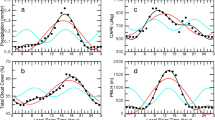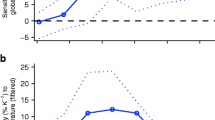Abstract
Main modes of variability of the Antarctic tropospheric circulation (500 hPa geopotential height) and precipitation are identified through their empirical orthogonal functions (EOF). This is done by combining various sources of information, including meteorological analyses and forecasts (NCEP and ECMWF), atmospheric general circulation model (LMDZ) simulations, and satellite data (GPCP). Unlike previous similar work on circulation variability, the mode analyses are restricted to the Antarctic region. The main modes that relate the Antarctic region to the mid and tropical latitudes, e.g. in association with ENSO, are nonetheless clearly identified and thus robust. The contribution of the sea-surface or of the circumpolar Antarctic atmospheric dynamics to the occurrence and to the chronology of these modes is evaluated through various atmospheric model simulations. EOF analyses results are somewhat less stable, across the various datasets, and more noisy for precipitation than for circulation. Yet, through moisture advection considerations, the two most significant precipitation modes can be well related to the three main modes of circulation variability. The signatures of both the Southern Oscillation Index (SOI) and the Antarctic Oscillation Index (AOI) are found in one same precipitation mode, suggesting that they have a substantially common spatial structure. In addition, the relative strength of the signature of the AOI and SOI appears to change in time. In particular, the signature of the SOI was weak in the 1980s precipitations, but turned very strong in the 1990s. Common spatial patterns and variable strength in time may explain why hints of an ENSO signature in Antarctic precipitation have been reported but not unequivocally demonstrated so far.

















Similar content being viewed by others
References
van den Broeke (2000) On the interpretation of Antarctic temperature time series. J Clim 13: 3885–3889
Bromwich DH, Rogers AN, Kallberg P, Cullather RI, White JWC, Kreutz KJ (2000) ECMWF analyses and reanalyses depiction of ENSO signal in Antarctic precipitation. J Clim 13: 1406–1420
Cavalieri D, Gloersen P, Parkinson C, Comiso J, Zwally H (1997) Observed hemispheric asymmetry in global sea ice changes. Science 278: 1104–1106
Comiso JC (2000) Variability and trends in Antarctic surface temperatures from in-situ and satellite infrared measurements. J Clim 13: 1674–1696
Connolley WM (1997) Variability in annual mean circulation in southern high latitudes. Clim Dyn 13: 745–756
Connolley WM (2002) Long-term variation of the Antarctic circumpolar wave. J Geophys Res (in press)
Cubash U, Meehl GA, Boer GJ, Stouffer RJ, Dix M, Noda A, Senior CA, Raper S, Yap KS (2001) Projections of future climate change. In: Houghton JT, Ding Y, Griggs DJ, Noguer M, van der Linden PJ, Dai X, Maskell K, Johnson CA (eds) Climate change 2001: the scientific basis. Cambridge University Press, Cambridge, UK, pp 881
Cullather RI, Bromwich DH, van Woert ML (1998) Spatial and temporal variability of Antarctic precipitation from atmospheric methods. J Clim 11: 334–368
Doran PT, Priscu JC, Lyons WB, Walsh JE, Fountain AG, McKnight DM, Moorhead DL, Virginia RA, Wall DH, Clow GD, Fritsen CH, McKay CP, Parsons AN (2002) Antarctic climate cooling and terrestrial ecosystem response. Nature 415: 517–519
Genthon C (2003) Climate and surface mass balance of the polar ice sheets in ERA40/ERA15. ECMWF Seminar Proceedings, in press.
Genthon C, Krinner G (1998) Convergence and disposal of energy and moisture on the Antarctic polar cap from ECMWF reanalyses and forecasts. J Clim 11: 1703–1716
Genthon C, Krinner G (2001) The Antarctic surface mass balance and systematic biases in GCMs. J Geophys Res 106: 20,653–20,664
Genthon C, Jouzel J, DéquéM (1994) Accumulation at the surface of polar ice sheets: Observation and modeling for global climate change. In: Desbois M, Desalmand F (eds) Global precipitation and climate change. Nato ASI Series I 26: 53–76
Genthon C, Krinner G, Cosme E (2002) Free and laterally-nudged Antarctic climate of an atmospheric general circulation model. Mon Weather Rev 130: 1601–1616
Gibson J, Kallberg KP, Uppala S, Noumura A, Hernandez A, Serrano E (1997) ERA description. ECMWF Re-Analysis Project Report Series 1, ECMWF, Reading, UK, pp 77
Gong D, Wang S (1999) Definition of Antarctic oscillation index. Geophys Res Lett 26: 459–462
Hines KM, Bromwich DH, Marshall GJ (2000) Artificial surface pressure trends in the NCEP/NCAR Reanalysis over the Southern Ocean and Antarctica. J Clim 13: 3940–3952
Huffman GT, Bovin DT (2001) GPCP version 2 combined precipitation data set documentation. Available at http://www1.ncdc.noaa.gov/pub/data/gpcp/v2/documentation
Ichiyanagi K, Numaguti A, Kato K (2002) Interannual variation of stable isotopes in Antarctic precipitation in response to El Nino Southern Oscillation. Geophys Res Lett 29: 1/1–1/4
Kalnay E, Kanamitsu M, Kistler R, Collins W, Deaven D, Gandin L, Iredell M, Saha S, White G, Woollen J, Zhu Y, Chelliah M, Ebisuzaki W, Higgins W, Janowiak J, Mo KC, Ropelewski C, Wang J, Leetmaa A, Reynolds R, Jenne R, Joseph D (1996) The NCEP/ NCAR 40-Year Reanalysis Project. Bull Am Meteorol Soc 76: 437–471
Kidson JW (1999) Principal modes of Southern Hemisphere low-frequency variability obtained from NCEP-NCAR reanalyses. J Clim 12: 2808–2830
King JC, Turner J (1997) Antarctic meteorology and climatology. Cambridge University Press, Cambridge, UK, pp 409
Krinner G, Genthon C (1998) GCM simulations of the Last Glacial Maximum surface climate of Greenland and Antarctica. Clim Dyn 14: 741–758
Krinner G, Genthon C, Li Z-X, Le Van P (1997) Studies of the Antarctic climate with a stretched grid GCM. J Geophys Res 102: 13,731–13,745
Kwok R, Comiso JC (2002) Southern ocean climate and sea ice anomalies associated with the Southern Oscillation. J Clim 15: 487–501
Lachlan-Cope TA, Connolley WM, Turner K (2001) The role of non-axisymetric orography in forcing the observed pattern of variability. Geophys Res Lett 28: 4111–4114
Marshall GJ (2002) Trends in Antarctic geopotential height and temperature: a comparison between radiosonde and NCEP-NCAR reanalysis data. J Clim 15: 659–674
Marshall GJ, Harangozo SA (2000) An appraisal of NCEP/NCAR reanalysis MSLP data viability for climate studies in the South Pacific. Geophys Res Lett 27: 3057–3060
North GR, Bell TL, Cahalan RF (1982) Sampling errors in estimation of empirical orthogonal functions. Mon Weather Rev 110: 699–706
von Storch H, Zwiers FW (2001) Statistical analysis in climate research. Cambridge University Press, Cambridge, UK, pp 484
Torinesi O, Fily M, Genthon C (2003) Variability and trends of summer melt period of Antarctic ice margins since 1980 from microwave sensors. J Clim (in press)
Trenberth KE (1984) Signal versus noise in the Southern Oscillation. Mon Weather Rev 112: 326–332
Trenberth KE, Carron JM (2000) The southern oscillation revisited: sea level pressures, surface temperatures, and precipitation. J Clim 13: 4358–4365
Trenberth KE, Branstator GW, Karoly D, Kumar A, Lau N-C, Ropelewsky C (1998) Progress during TOGA in understanding and modeling global teleconnections associated with tropical sea surface temperatures. J Geophys Res 103: 14,291–14,324
Vaughan DG, Marshall GJ, Connolley WM, King JC, Mulvaney R (2001) Devil in the detail. Science 293: 177–179
Wallace JM, Thomson DWJ (2002) Annular modes and climate prediction. Phys Today 55: 28–33
Yuan X, Martinson DG (2000) Antarctic sea ice extent variability and its global connectivity. J Clim 13: 1697–1717
Acknowledgements.
This work is supported by the French Climate Dynamics program (PNEDC). Computing time for the LMDZ runs was provided by IDRIS (Institut du Developpement et des Ressources en Informatique Scientifique, Orsay) and CEA (Commissariat àl'Energie Atomique, Grenoble). NCEP data are provided by the NOAA-CIRES Climate Diagnostics Center at http://www.cdc.noaa.gov/cdc/data.ncep.reanalysis.html/. The GPCP data are provided by NOAA National Climatic Data Center at http://www.ncdc.noaa.gov/oa/wmo/wdcamet-ncdc.html. Comments by William Connolley and an anonymous reviewer helped improve a first version of this work.
Author information
Authors and Affiliations
Corresponding author
Rights and permissions
About this article
Cite this article
Genthon, C., Krinner, G. & Sacchettini, M. Interannual Antarctic tropospheric circulation and precipitation variability. Climate Dynamics 21, 289–307 (2003). https://doi.org/10.1007/s00382-003-0329-1
Received:
Accepted:
Published:
Issue Date:
DOI: https://doi.org/10.1007/s00382-003-0329-1




